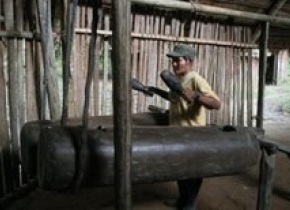
博拉人的困境:最后的击鼓传信
生活在亚马逊西北部的博拉人使用鼓来传送长距离的语言信息。
撰文\播音:克里斯托弗•因塔利亚塔(Christopher Intagliata)
翻译:陈美娟
审校:张清越
Before the internet or cell phones, radio or telegraph, long-distance communication meant riders on horseback, carrier pigeons or semaphore. But various cultures also developed ways to produce audio messages that travel miles—like the sounds of the manguaré drums of the Bora people in the northwestern Amazon.
在互联网或手机、无线电或电报发明出来之前,提到远距离通信免不了提到信使,信鸽或信号灯。但是各种文化也发展出了不同的传递语音信息方法,例如,生活在亚马逊河西北部的博拉人用曼古尔鼓声来传递信息。
The drums look like wooden cannons, with a slit on top. A player stands between two of them and beats out a rhythm—either purely musical, or a Morse code–like message. For example:
"Bring the coca leaves for toasting."
这种鼓看起来像木制的大炮,鼓面顶部有一个狭缝。一位击鼓者站在两鼓之间,用单纯的音乐性或莫尔斯电码般的敲击节奏来传达信息。例如:
“拿可可树叶过来烤。”
"They have this fantastic sound which resounds through the jungle and can be heard up to 15 to 20 kilometers away." Frank Seifert, a linguist at the University of Amsterdam and the University of Cologne. "That extends the range of the human voice by about a hundred."
“这种奇妙的声音在丛林中回荡,让人可以在15到20公里以外听到。”阿姆斯特丹大学和科隆大学的语言学家弗兰克·塞弗特这样说道。“这将人类声音可传播的范围扩大了大约一百倍。”
There's a drinking game in Bora culture: who can drink the most cahuana, a non-alcoholic cassava drink. The winner might declare, <
Seifert and his team analyzed those beats and the corresponding spoken phrases, < the pauses corresponded to the number of vowels and consonants in the phrases.
在博拉文化中有一种饮酒游戏:比赛谁可以喝最多的卡瓦纳,一种非酒精木薯饮料。获胜者可能会宣布,<
塞弗特和他的团队分析了这些节拍和对应的口语短语,并发现短语的停顿与元音和辅音的数量相对应。
"Depending whether the vowel is long or short, and whether there's consonants intervening between the vowels, the pauses between the beats are going to be shorter or longer."The findings are in the journal Royal Society Open Science. [Frank Seifart et al., Reducing language to rhythm: Amazonian Bora drummed language exploits speech rhythm for long-distance communication]
“根据元音的长短,以及是否有辅音介于元音之间,节拍之间的停顿会因而更短或更长。”
这一发现发表在《皇家学会公开科学》杂志上。
Seifert says studies of Bora drumming may ultimately reveal something more fundamental about spoken language. "I think that shows very clearly how this fine temporal structure of language, this rhythmic structure embedded in speech, how important that is for language processing in general."
塞弗特说,对博拉鼓声文化的研究也许最终能揭示更多口语的本质。“我认为,这清楚地显示了这种时间结构的精妙性和嵌入在言语中的节奏性对于语言处理来说是多么重要。”
In the early 1900s, manguaré drums were reportedly heard daily in this part of the Amazon. Today, only 20 drums remain, and the Bora language is losing turf to Spanish. But for now…the beat goes on.
据报道,在1900年代早期,亚马逊的这部分地区每天都能听到曼古尔鼓声。如今仅存20面鼓,博拉语言更是在西班牙语的优势地位下逐渐失去影响力。但就目前而言,这门语言的灵越性还在持续。
未经书面许可任何人不得复制或镜像
京ICP备11000850号-1
 京公网安备11010502039775号
京公网安备11010502039775号 信息网络传播视听节目许可证0111611号
国家科技基础条件平台

















